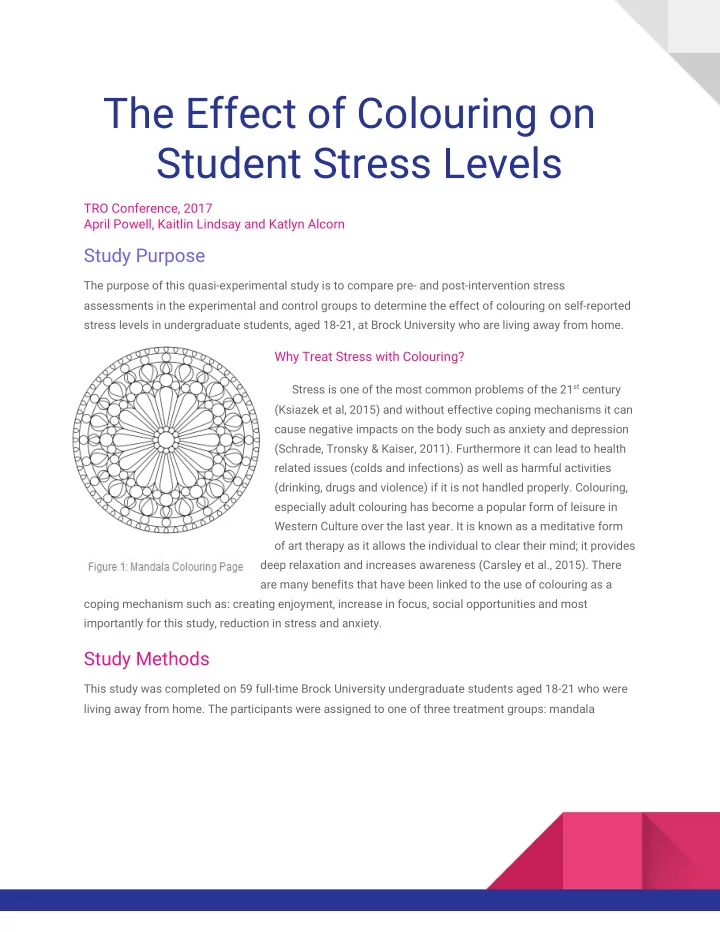

The Effect of Colouring on Student Stress Levels TRO Conference, 2017 April Powell, Kaitlin Lindsay and Katlyn Alcorn Study Purpose The purpose of this quasi-experimental study is to compare pre- and post-intervention stress assessments in the experimental and control groups to determine the effect of colouring on self-reported stress levels in undergraduate students, aged 18-21, at Brock University who are living away from home. Why Treat Stress with Colouring? Stress is one of the most common problems of the 21 st century (Ksiazek et al, 2015) and without effective coping mechanisms it can cause negative impacts on the body such as anxiety and depression (Schrade, Tronsky & Kaiser, 2011). Furthermore it can lead to health related issues (colds and infections) as well as harmful activities (drinking, drugs and violence) if it is not handled properly. Colouring, especially adult colouring has become a popular form of leisure in Western Culture over the last year. It is known as a meditative form of art therapy as it allows the individual to clear their mind; it provides deep relaxation and increases awareness (Carsley et al., 2015). There are many benefits that have been linked to the use of colouring as a coping mechanism such as: creating enjoyment, increase in focus, social opportunities and most importantly for this study, reduction in stress and anxiety. Study Methods This study was completed on 59 full-time Brock University undergraduate students aged 18-21 who were living away from home. The participants were assigned to one of three treatment groups: mandala
pattern, sea turtle pattern or control and each group followed the same procedures. The tool used to measure stress was the State Trait Anxiety Inventory (STAI), which was completed by the participants 3 times throughout their participation. Study participants also went through a brief stress induction with one of the student investigators prior completing their assigned treatment for 20 minutes. After the students were done they were asked to write out 5 happy memories and given a resource sheet with coping mechanisms for stress as well as counselling services both at Brock and in the Niagara region. The Statistics Show… ● Hypothesis 1: Colouring groups will report lower stress levels post-intervention when compared to the control group → Supported ○ The mean scores for both the mandala and sea turtle group was lower post intervention than the control group ● Hypothesis 2: The mandala colouring group will report the largest difference in pre- and post-intervention scores → Supported ○ After running a post hoc tukey test the significance between the three groups was discovered to lie between the mandala and the sea turtle and control groups ● Hypothesis 3: The control group will report higher stress at the end of the study when compared to their initial scores → Supported ○ The descriptives table illustrates an increase in post test scores of the control group when compared to their baseline scores ● Gender: ○ Males did not experience the same degree of stress reduction following the intervention as females ○ However they still experienced some level of stress reduction following the colouring intervention Relation to Therapeutic Recreation There are many ways in which colouring can provide therapeutic benefits to individuals. Colouring can be used as an alternative to meditation by relaxing the amygdala. It can provide individuals with a focus to assist with redirecting attention from negative habits issues, and focus on more productive thoughts. Colouring can be beneficial to persons of all ages. For adults it allows them to reminisce about simpler times and invoke childhood memories. It can encourage positive thinking and assist with memory, in some cases colouring can provide that individual comfort to decrease loneliness and agitation. Colouring
can allow teens an opportunity to cope with stress and explore their interests. For children colouring an image can allow that child to experience an increase in self-esteem and creativity through sense of accomplishment. As professionals it is important to practice what we preach. Colouring can be an opportunity for self-care by allowing us as TR professionals an opportunity to hone in on our current needs and to make time for ourselves in our busy days. For some, colouring may be an effective way of recharging after a hectic day or an opportunity for some quiet time to wind down. Takeaways From this study we were able to determine that the mandala pattern was the most effective pattern for stress reduction. Even though the sea turtle picture did not provide statistically significant evidence that it was able to reduce stress the mean post- test scores of the pattern did drop which allows us to believe that colouring (even if it is not a mandala pattern) can still be used as a coping mechanism for stress. Overall, colouring is a beneficial coping mechanism for reducing stress for full-time Brock University students aged 18-21 who are living away from home References Carsley, D., Heath, N., & Fajnerova, S. (2015). Effectiveness of a classroom mindfulness colouring activity for test anxiety in children. Journal of Applied School Psychology, 31 (3), 239-255. Ksiazek, P., Grabska, K., Trojanowska, D., Slowinska, A., Dreher, P., Scirka, N., & Dreher, S. (2015). Stress and methods of coping with it among students of the Medical University of Lublin. Polish Journal Of Public Health , 125 (2), 94-98. doi:10.1515/pjph-2015-0032 Schrade, C., Tronsky, L., & Kaiser, D. (2011). Psychological effects of mandala making in adults with intellectual disability. The Arts in Psychotherapy, 38 , 109-113.
Recommend
More recommend